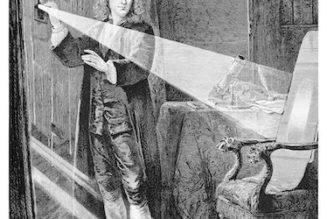
Would religious thinkers in times before the Scientific Revolution ever have considered accepting the word of scientists over a plain reading of the Bible? Yes, they would have. And, in fact, they did. St. Augustine, St. Thomas Aquinas, and John Calvin all took the words of astronomers over a plain reading of Genesis 1:14–16. All three argued for interpreting these scriptural verses in light of what science had discovered and therefore held those verses to be describing celestial bodies not as they are in themselves, but as they appear to human eyes.
Genesis 1:14–16 describes the creation of the Sun, Moon, and stars:
And God said: Let there be lights made in the firmament of heaven, to divide the day and the night, and let them be for signs, and for seasons, and for days and years: To shine in the firmament of heaven, and to give light upon the earth. And it was so done. And God made two great lights: a greater light to rule the day; and a lesser light to rule the night: and the stars.
The scientific question this raises is about the “two great lights,” the Sun and the Moon, and whether they are indeed greater than other celestial bodies. In particular, is the Moon greater—in the sense of larger—than the other lights in the sky, i.e. the stars and the planets?
If the sky were a dome, as the ancient Hebrews believed, then the relative “greatness” of these bodies could be judged simply from their appearance. The Sun, Moon, and stars, all being placed on that spherical dome with us at the center, would all be the same distance from us, and consequently, their true relative sizes and brightnesses would be just as they appear to our eyes.
But, in fact, these bodies are not all the same distance from the Earth. For example, it is obvious from solar eclipses that the Sun is farther away from us than the Moon, because in such eclipses the Moon is seen to pass between the Earth and the Sun. Indeed, the Sun is much farther away from us than the Moon, as astronomers of the ancient world were able to show through careful observations and geometry. If one combines that fact with the fact that Sun and Moon look about the same size as seen from Earth—in a solar eclipse the Moon’s disk approximately covers that of the Sun—it follows that the Sun must in reality be a much larger body than the Moon. That conclusion presents no scriptural difficulty, however, since Genesis 1:16 refers to the Sun as “the greater light” of the two.
The stars, on the other hand, do present a difficulty. In the second century AD, the Greek-Egyptian astronomer Ptolemy had worked out a sophisticated theory of the universe that would dominate astronomy up into the seventeenth century. In it, the Earth, while at the universe’s center, was merely a speck or “point” in comparison to the distance to the stars. As Ptolemy put it in his book, the Almagest:
Now, that the Earth has sensibly the ratio of a point to its distance from the sphere of the so-called fixed stars gets great support from the fact that in all parts of the Earth the sizes and angular distances of the stars at the same times appear everywhere equal and alike, for the observations of the same stars in the different latitudes are not found to differ in the least.
In other words, the Earth must be tiny compared to the distance to the stars because observers at different locations on Earth’s surface see no difference in the brightness and relative locations of the stars in the sky. An observer near the equator who sees stars overhead will be perhaps a thousand miles closer to those stars than an observer at mid-latitude. Because that span of miles does not alter the appearance of those stars, it must be negligible compared to the stars’ distance from the Earth.
Because of their vast distance from us, Ptolemy deduced that the stars must be of gigantic size to appear to us as they do. According to his calculations, the actual diameter of the most prominent stars was more than four times that of Earth. He also calculated that the Sun’s diameter is five times that of Earth, while the Moon’s diameter is only about one-third of Earth’s. A prominent star was therefore far greater in actual size than the Moon, despite appearances. Indeed, every visible star in the night sky would exceed the Moon in bulk. If one accepted Ptolemy’s calculations, the Moon would hardly qualify as one of the “great” heavenly lights.
Ptolemy’s arguments were persuasive. His conclusions seemed to be based on sound scientific reasoning and were accepted by Christian writers, despite what Genesis 1:14–16 seemed to say. Consider, for example, St. Severinus Boethius’s On the Consolation of Philosophy, written in the year 523. Citing Ptolemy by name, Boethius wrote,
You have learned from astronomy, that this globe of earth is but as a point in respect to the vast extent of the heavens; that is, the immensity of the celestial sphere is such that ours, when compared with it, is as nothing, and vanishes.
St. Augustine (354–430) likewise did not reject ideas from science. Indeed, in his treatise On the Literal Interpretation of Genesis he warned at length against citing Scripture over science, mentioning astronomical ideas specifically:
There is knowledge to be had, after all, about the Earth, about the sky, . . . about the movements and revolutions or even the magnitude and distances of the constellations, about the predictable eclipses of Moon and Sun. . . . And it frequently happens that even non-Christians will have knowledge of this sort in a way that they can substantiate with scientific arguments or experiments. Now it is quite disgraceful and disastrous, something to be on one’s guard against at all costs, that they should ever hear Christians spouting what they claim our Christian literature has to say on these topics, and talking such nonsense that they can scarcely contain their laughter when they see them to be . . . wide of the mark. And what is so vexing is . . . that our authors should be assumed by outsiders to have held such views and, to the great detriment of those about whose salvation we are so concerned, should be written off and consigned to the waste paper basket as so many ignoramuses.
Whenever, you see, they catch out some members of the Christian community making mistakes on a subject which they know inside out, and defending their hollow opinions on the authority of our books, on what grounds are they going to trust those books on the resurrection of the dead and the hope of eternal life and the kingdom of heaven, when they suppose they include any number of mistakes and fallacies on matters which they themselves have been able to master either by experiment or by the surest of calculations?
Elsewhere in the same treatise, St. Augustine directly discussed the issue of the sizes of stars and Genesis 1:14–16:
A question also commonly asked is whether these conspicuous lamps in the sky, that is, Sun and Moon and stars, are all equally brilliant, but because of their different distances from the earth appear to our eyes for that reason to vary in brightness. And, about the Moon, those who take this line do not hesitate to say that its light is in itself less than that of the Sun, by which they also maintain it is illuminated. Many of the stars, however, so they boldly assert, are equal to the Sun, or even greater, but they seem small because they have been set further away.
After further elaborating on what might be said about the celestial lights, St. Augustine concluded:
But let them say what they like about the heavens, those who are strangers to the Father who is in heaven. As for us, though, it is not our business to inquire more precisely into the size and the spacing of the constellations, spending time on such things that is needed for more important and worthy matters. We even think it more worthwhile to attend to those lights that are greater than the rest, which Scripture draws to our attention as follows: And God made two great lights, which for all that are not equal. It goes on to say, you see, after putting them ahead of the rest, that they differ from each other. It says, I mean: the greater light for the starting of the day, and the lesser light for the starting of the night (Gen 1:16). Let them at least grant this to our eyes, after all, that it is obvious that they shine more brightly than the rest upon the earth, and that it is only the light of the Sun that makes the day bright, and that even with so many stars appearing, the night is never as light when there is no Moon, as when it is being illuminated by its presence.
Note what St. Augustine said: “to our eyes” the Sun and Moon are the two great lights; they provide much greater illumination to the Earth than the stars do. That is his solution to the conflict between the scriptural expression “the two great lights” and the results of astronomical observations, measurements, and calculations.
St. Thomas Aquinas (1225–74) said the same thing, centuries later. In his Summa Theologica, Question 70 (“Of the Work of Adornment, as regards the Fourth Day, in Three Articles”), he considers objections to the Genesis account regarding the lights. Among these, he notes:
Objection. 5. Further, as astronomers say, there are many stars larger than the Moon. Therefore, the Sun and the Moon alone are not correctly described as “the two great lights.”
He answered this is as follows:
Reply to Objection 5. As Chrysostom says, the two lights are called great, not so much with regard to their dimensions as to their influence and power. For though the stars be of greater bulk than the Moon, yet the influence of the Moon is more perceptible to the senses in this lower world. Moreover, as far as the senses are concerned, its apparent size is greater.
This manner of thinking was not the province of Catholics only. Consider, for example, the Protestant Reformer John Calvin (1509–64). In his commentary on Genesis, Calvin made the same point that St. Augustine and St. Thomas had made regarding the two great luminaries, but drove that point home at considerably greater length:
Moses makes two great luminaries; but astronomers prove, by conclusive reasons that the star of Saturn, which on account of its great distance, appears the least of all, is greater than the Moon. Here lies the difference: Moses wrote in a popular style things which, without instruction, all ordinary persons endued with common sense are able to understand; but astronomers investigate with great labor whatever the sagacity of the human mind can comprehend. Nevertheless, this study is not to be reprobated, nor this science to be condemned, because some frantic persons are wont boldly to reject whatever is unknown to them. For astronomy is not only pleasant, but also very useful to be known: it cannot be denied that this art unfolds the admirable wisdom of God. Wherefore, as ingenious men are to be honored who have expended useful labor on this subject, so they who have leisure and capacity ought not to neglect this kind of exercise. Nor did Moses truly wish to withdraw us from this pursuit in omitting such things as are peculiar to the art; but because he was ordained a teacher as well of the unlearned and rude as of the learned, he could not otherwise fulfill his office than by descending to this grosser method of instruction. Had he spoken of things generally unknown, the uneducated might have pleaded in excuse that such subjects were beyond their capacity. Lastly since the Spirit of God here opens a common school for all, it is not surprising that he should chiefly choose those subjects which would be intelligible to all. If the astronomer inquires respecting the actual dimensions of the stars, he will find the Moon to be less than Saturn; but this is something abstruse, for to the sight it appears differently. Moses, therefore, rather adapts his discourse to common usage. For since the Lord stretches forth, as it were, his hand to us in causing us to enjoy the brightness of the Sun and Moon, how great would be our ingratitude were we to close our eyes against our own experience? There is therefore no reason why janglers should deride the unskillfulness of Moses in making the moon the second luminary; for he does not call us up into heaven, he only proposes things which lie open before our eyes. Let the astronomers possess their more exalted knowledge; but, in the meantime, they who perceive by the Moon the splendor of night, are convicted by its use of perverse ingratitude unless they acknowledge the beneficence of God.
Calvin chose for his example the planet Saturn rather than a star, but the basic point is the same. Calvin discussed the same issues in his commentary on Psalm 136, which in verses 7–9 also speaks of the “great lights”:
Praise the Lord…
Who made the great lights:
for his mercy endureth forever.
The Sun to rule the day:
for his mercy endureth forever.
The moon and stars to rule the night:
for his mercy endureth forever.
Calvin wrote:
Moses [in Genesis 1:16] calls the Sun and Moon the two great lights, and there is little doubt that the Psalmist here borrows the same phraseology. What is immediately added about the stars, is, as it were, accessory to the others. It is true, that the other planets are larger than the Moon, but it is stated as second in order on account of its visible effects. The Holy Spirit had no intention to teach astronomy; and, in proposing instruction meant to be common to the simplest and most uneducated persons, he made use by Moses and the other Prophets of popular language, that none might shelter himself under the pretext of obscurity, as we will see men sometimes very readily pretend an incapacity to understand, when anything deep or recondite is submitted to their notice. Accordingly, as Saturn, though bigger than the Moon, is not so to the eye owing to its greater distance, the Holy Spirit would rather speak childishly than unintelligibly to the humble and unlearned.
Unlike St. Augustine and St. Thomas, Calvin was alive in 1543 when Nicolaus Copernicus’s On the Revolutions of Celestial Spheres was published. But Calvin was no fan of Copernicus’s idea that the Earth orbits the Sun annually and rotates on its own axis daily:
We will see some who are so deranged, not only in religion but who in all things reveal their monstrous nature, that they will say that the Sun does not move, and that it is the Earth which shifts and turns. When we see such minds, we must indeed confess that the devil possesses them, and that God sets them before us as mirrors, in order to keep us in his fear. So it is with all who argue out of pure malice, and who happily make a show of their imprudence. When they are told: “That is hot,” they will reply: “No, it is plainly cold.” When they are shown an object that is black, they will say that it is white, or vice versa.
Why did Calvin say this? If he accepted the science that said the Moon is smaller than Saturn and the stars, an idea contrary to the “plain words” of Scripture, why, was he unwilling to accept the science that said the Earth circles the Sun, an idea also contrary to the “plain words” of Scripture?
Calvin was not alone in this. Presumably most educated Christians of the sixteenth and seventeenth centuries had no difficulty in accepting that the stars were larger than the Moon, as Calvin did, and as such great figures as St. Augustine and St. Thomas Aquinas had done long before him. Indeed, a standard treatise on astronomy by the widely-read Jesuit astronomer Christopher Clavius (1537–1612) lists the Moon as being far smaller than the stars. And yet, many of the same people (including Clavius) rejected Copernicus’s theory that the Earth circled the Sun and they did so partly on scriptural grounds. Why the different attitudes in the two cases? What was going on?
What was going on was that the case for stars and planets being larger than the Moon was much more persuasive in scientific terms at that time than the case for Earth circling the Sun. In fact, Calvin did not even see the claim that Earth orbits (“shifts”) and rotates (“turns”) as having any basis in science; he acknowledged no motivation for it other than base contrariness. And even a century after Calvin, and after Galileo, many educated people, including leading astronomers, did not find the scientific case for the Earth’s motion compelling.
And there were good reasons for this, despite the view so widely held today that the scientific case for Copernicanism was overwhelmingly strong in the seventeenth century, at least after the work of Galileo. Many imagine, for example, that the invention of the telescope provided the means to easily demonstrate that Copernicus was correct, so that Galileo was “proving, for the first time, that the Earth revolves around the Sun,” and that those who opposed Copernicanism were akin to modern “science deniers.” The fact is, however, that the scientific weaknesses of the case for Copernicanism as it stood for most of the seventeenth century were many.
One weakness was that there was no physics to explain how the Earth, an incredibly heavy ball of rock 25,000 miles around, could be made to move. A moving Sun, by contrast, could be explained by assuming it to be made of some very light, ethereal substance that moved with ease. Another weakness was that no experiment at that time revealed any effect resulting from Earth’s hypothesized motion; yet the rotation of the Earth assumed in Copernicus’s theory implied that every person on it is moving at speeds of hundreds of miles per hour (and the Earth’s orbital motion implied far greater speeds still).
A third weakness, remarkably enough, had to do with the stars and their sizes. If Earth circled the Sun, then Earth’s orbit could replace Earth’s surface in Ptolemy’s argument about the distance to the stars. Observers at different locations on Earth’s orbit see no difference in the brightness and relative locations of the stars in the sky; so Earth’s orbit is like a point compared to the distance to the stars. A prominent star then becomes, not four times the diameter of Earth, and thus a little smaller than the Sun, but four times the diameter of Earth’s orbit. That prominent star now utterly dwarfs the Sun. For that matter, so does every star seen in the night sky, even the least prominent.
This star size problem was pointed out by Tycho Brahe (1546–1601), the most prominent astronomer of his time. It was driven home by various other astronomers in the seventeenth century, such as André Taquet, S.J. (who explicitly made the point about exchanging Earth’s orbit for Earth’s surface in Ptolemy’s argument, and who also made a point about Galileo being unable to explain away this scientific weakness of the Copernican hypothesis), and such as Simon Marius and Giovanni Battista Riccioli, S.J. (who showed that the problem remained even when stars were studied telescopically). All these astronomers rejected both the Copernican model of the solar system and the older Ptolemaic model. They supported other hypotheses about the structure of the solar system, hypotheses that were compatible both with the new discoveries taking place in astronomy during their time and with the idea of an unmoving Earth (and the reasonably-sized stars that an unmoving Earth allowed for).
What was going on, then, with Calvin’s accepting of the Moon being smaller than the stars yet rejecting the Earth circling the Sun, was this: he was weighing the scientific evidence that was available in his day (Calvin was not around for Brahe’s ideas, the advent of the telescope, and the in-depth studies of the sizes of stars). The fact that he readily accepted conclusions about the sizes of the Sun, Moon, and planets shows that he did not automatically put the “plain words” of Scripture over the results of science.
Indeed, Calvin strongly supported interpreting Genesis 1:16 as speaking of the Moon and stars appearing “great” to our eyes, and simultaneously praised astronomy as a “pleasant” art that “unfolds the admirable wisdom of God,” one for which “ingenious men” should be honored for their “useful labor,” and one that produces “exalted” knowledge that can be “conclusive” even when seeming at first glance to contradict Genesis. He could have likewise strongly supported interpreting Ecclesiastes 1:5 (“the Sun riseth, and goeth down, and returneth to his place: and there rising again”) as also speaking of how things appear to our eyes. Even today we speak of sunrises and sunsets, despite every schoolchild learning that the Earth turns. But for Calvin to have supported that interpretation of Ecclesiastes, he presumably would have needed evidence in support of Earth’s motion that was as convincing as the evidence in support of the Moon being smaller than the stars.
We can presume that St. Augustine and St. Thomas would have thought likewise. So would many of those who opposed Copernicanism in the seventeenth century. Indeed, when Galileo was advocating the Copernican hypothesis, various people told him that if the evidence required it Scripture would simply have to be reinterpreted so that verses such as Ecclesiastes 1:5 are read as describing the universe as it appears to human eyes gazing up from Earth’s surface, and not as describing the universe in absolute terms. Among these were Cardinal Carlo Conti in 1612, Cardinal St. Robert Bellarmine in 1615, and the Jesuit astronomer Orazio Grassi in 1624. But one did not treat Scripture lightly; one did not do this unnecessarily. The evidence had to be solid.
We come now to a final irony: the scientific evidence regarding the size of the Moon versus the stars—the evidence that over a span of more than a thousand years had persuaded St. Augustine, St. Thomas Aquinas, John Calvin, Christopher Clavius, and others—turned out not to be solid. In the latter half of the seventeenth century, decades after Galileo’s death, evidence began to surface that the apparent sizes of stars in the sky are a kind of illusion. Over the next century and a half, astronomers developed a full understanding of how the apparent widths of stars, whether seen with the eye or with a small telescope, are simply a product of the eye or telescope, the air, and the laws of optics. When you see the Sun and Moon, you see the body of the Sun and the body of the Moon, and their widths. When you see the stars, however, you see their light, but you are not really seeing their widths—they are too far away for their widths to be discernable by the eye or small telescopes. Brahe’s star size argument against the Copernican hypothesis crumbled—and that, together with the rise of Newtonian physics, which could explain Earth’s motion, and the discovery of subtle effects caused by Earth’s motion, ushered in Copernicanism’s broad acceptance among scientists.
Ptolemy had been dead wrong about the sizes of stars. To be clear, today we do know that stars are far larger than the moon, but this knowledge is not based on their sizes as they appear in the sky; it comes from other studies of the stars. St. Augustine, St. Thomas Aquinas, and Calvin—Christian thinkers spread out over more than a thousand years—all interpreted Genesis 1:14–16 on the basis of scientific evidence that turned out to be illusory. Science that for more than a millennium seemed solid, was wrong. The Contis, Bellarmines, and Grassis of the world—those people not at all eager to reinterpret Scripture in light of scientific developments—had a point, and perhaps a very sober view of the changeable nature of scientific ideas.
The usual story of religion and science typically features neither Christian thinkers who are willing to accept scientific results that seem contrary to Scripture, nor Christian thinkers who are hesitant to do so on reasonable grounds. From the idea put forth in the nineteenth century of a “warfare between science and theology,” to the idea put forth even today that, “for most of its history the Catholic Church rejected scientific findings that conflicted with its doctrine,” the often-told story is that Christian thinkers have typically rejected science in favor of a plain reading of Scripture. St. Augustine, St. Thomas, Calvin and their views on Genesis 1:14–16 tell us a much more interesting and complex story. That story both refutes the often-told story and gives insight into the complex nature of scientific ideas, which can be of varying strengths and subject to change. “Following the science” is not always a simple matter.
EDITORIAL NOTE: This article is part of a collaboration with the Society of Catholic Scientists (click here to read about becoming a member). A version of this article with extensive foonotes is available here.
Join Our Telegram Group : Salvation & Prosperity








